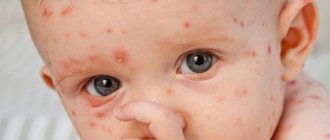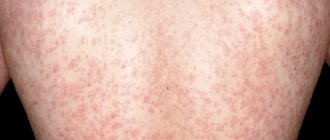The consequences of chickenpox in adult men are primarily caused by the severe course of the disease and the fact that chickenpox is more common among the male population. This contagious disease has a 100% susceptibility of the body and is an acute infection caused by the varicella-zoster virus from the Herpetoviridae family, transmitted by airborne droplets through contact with an infected person. Outside the body, the virus dies quite quickly - sunlight and UV radiation contribute to the rapid inactivation of the pathogen.
Smallpox is usually classified as a viral disease of childhood, but due to its widespread distribution and high susceptibility, chickenpox is often found in adult men. Chickenpox is considered a simple disease, although there is a high risk of severe complications (in approximately 1-5% of adult patients), including death, and this is 10-20 times higher than in children.
How dangerous is chickenpox for men and in what cases is there a risk of complications?
Chickenpox development and symptoms
Like any other viral disease, chickenpox has several periods of progression:
- Incubation . This period lasts from 10 to 21 days, depending on age, immunity and aggressiveness of the virus strain.
- Prodromal . The period when the first general signs of the disease appear - fever up to 39 ° C, headache, nausea or vomiting, aching bones. Usually lasts no more than two days.
- High period . At the beginning of this period, pink spots appear on the body, which soon turn into blisters with liquid. After a short period of time, the blisters burst, leaving itchy sores in their place. This period lasts 8-12 days.
- Recovery period . The beginning of this period can be considered the moment when the crusts that cover the ulcers begin to dry out and fall off. However, a person is contagious for another 5-6 days after the last scabs fall off.
In the last ten days of the incubation period, a person already becomes a source of the virus. Therefore, after contact with a sick person, it is best to avoid large crowds of people for the next ten days.
Hygiene rules for patients with chickenpox
In cases where chickenpox goes away without an increase in temperature, but rashes appear on the body, it is worth abandoning water procedures. You are allowed to take a shower when the blisters dry out and begin to crust over. While bathing, you should not use a washcloth so as not to damage the surface of the healing wounds or introduce an infection into them.
Children are washed in a bath with the addition of manganese. Instead of a weak pink solution, you can use a decoction of herbs that have an anti-inflammatory, drying effect. To prepare a healing font you can use:
- chamomile;
- sage;
- calendula;
- oak bark
After taking a bath or shower, you should carefully pat your body dry with a soft towel. Do not rub the skin.
Linen and bedding of a patient with chickenpox should be washed frequently. Doctors advise wearing cotton clothes. It is better to choose loose shirts with long sleeves; trousers should have long legs. The smallest ones wear undershirts with sewn ends of the sleeves.
To prevent the baby from scratching the wounds, you need to cut the nails short. If there are not a lot of rashes on your hands, then you can use baby soap or wipe your palms with an antiseptic.
Diagnostics
Chickenpox manifests itself as characteristic rashes on the body. Diagnosis is not difficult.
Diagnosis of chickenpox is made on the basis of the typical clinical picture it gives at the height of the disease:
- the appearance of vesicles (bubbles) with liquid, which then burst. Occur randomly on all parts of the body, including the mucous membranes of the mouth, eyes and genitals;
- severe itching;
- periodic jumps in body temperature up to 40 ° C;
- severe intoxication of the body, often accompanied by nausea, vomiting, and headache.
Immunity and course of chickenpox
Chickenpox without fever in adults and children is possible with a high level of general body resistance. A good immune system allows you to tolerate the infection in a mild form. In such cases there is no fever, and skin rashes are extremely scarce. Often they do not even reach the stage of vesicles and crusts, but are limited to the stage of the primary morphological element - spots.
With such subtle clinical manifestations, patients may not suspect that they have had chickenpox. The diagnosis can be established by laboratory serological method. Blood for immunoglobulins M and G to the varicella-zoster virus, which is the causative agent of chickenpox, can be tested at the onset of the disease and after 2-3 weeks. An increase in the titer of specific antibodies by 4 times is considered significant in terms of confirming the diagnosis. The method is applicable for retrospective diagnosis.
Complications
Chickenpox in most cases is benign. But in adults, especially those weakened by another recent disease, or after long-term drug treatment, complications may occur:
- suppuration of rashes and formation of skin scars;
- abscesses, phlegmons;
- sepsis;
- rashes on the eyeball and clouding of its structures;
- bacterial pneumonia;
- myocarditis;
- encephalitis.
Read: What vitamins are needed to maintain a man’s immunity?
Immunodeficiency conditions
A high risk of developing malignant (generalized, gangrenous, bullous) forms of chickenpox in an adult male is present in immunodeficiency states of any origin, involving the T-cell component of immunity. This primarily concerns patients with HIV infection and chronic diseases such as diabetes mellitus, autoimmune disorders, bronchial asthma, leukemia, systemic connective tissue pathologies, and oncology.
The state of immunodeficiency, even with strict adherence to the rules of personal hygiene and all doctor’s recommendations, provokes the development of purulent, inflammatory skin diseases, namely:
- bullous steptoderma - a contagious skin disease that is manifested by the formation of large blisters with fluid on the surface of the epidermis;
- abscess - accumulation of purulent masses in places of inflammatory process;
- phlegmon - extensive purulent inflammation of connective tissue, fiber;
- erysipelas is a dermatic, contagious, recurrent infectious disease.
The basis of all these purulent skin diseases is superinfection with staphylococci or streptococci. Causes of occurrence, in addition to immunodeficiency, include scratching by patients of itchy areas and repeated infection. This leads to long-term drug therapy.
Complicated forms of the disease
Complicated forms of chickenpox include three forms of the disease:
- Hemorrhagic - capillaries are involved in the pathological process, the contents of the vesicles become bloody, which creates optimal conditions for the development of pathogenic microflora.
- Gangrenous - zones of necrosis form around the rash, deep layers of the skin are affected - after recovery, scars remain on the skin.
- Bullous - large blisters form on the skin, which, as they burst, turn into non-healing wounds.
Chickenpox during pregnancy
If a woman does not have immunity to the chickenpox pathogen at the time of conscious planning of pregnancy, she will be recommended to undergo appropriate vaccination. Infection during pregnancy is dangerous for the fetus until about 20 weeks. At this stage, the virus causes intrauterine death of the fetus, which ends in miscarriage or stillbirth. It is also possible to develop severe defects that lead to disability of the born child.
At later stages, the effect of the virus on the body of both mother and fetus weakens, reaching a second peak immediately before childbirth. Infection with chickenpox in the later stages is fraught with the development of pneumonia, which can also lead to the death of the child. In such cases, special therapy with immunoglobulins and specific antibodies is carried out.
Lack of immunity to chickenpox in general is not an indication for termination of pregnancy.
Specific male problems
Fertility and potency will be restored after full recovery
Chickenpox can have some impact on a man's sex life due to three factors:
- Full sex is impossible during the height of the disease due to, as a rule, the man’s poor health.
- Vesicles may appear on the penis and until they heal, full sex is impossible. Suppuration of the rash can cause severe inflammation, and, as a rule, severe pain and decreased libido.
- After recovery, the quality of the ejaculate decreases for some time, so a man’s fertility decreases after recovery.
How can you get chickenpox?
In order to become infected with chickenpox, sometimes it is enough just to be in a room where a sick person was present some time ago. The virus is so small and light that it can be carried by air currents over significant distances. That is why the disease was called chickenpox. The only fact that can restrain the rapid spread of the infection is that the pathogen, once outside the body, dies in about 10 minutes.
The patient begins to release the pathogen into the environment several days before the visual debut of chickenpox, that is, it is impossible to completely exclude the possibility of infection if the person does not have immunity to the chickenpox virus or is not vaccinated.
If one child in a children's group gets chickenpox, the entire group or class is quarantined.
Treatment
As a rule, complete treatment of chickenpox, that is, aimed at destroying the pathogen, is not carried out. Symptomatic treatment is usually used:
- Rashes are treated with brilliant green solution
Treatment of rashes . Rashes need to be disinfected to eliminate unwanted pathogenic microflora and dried so that crusts form as quickly as possible. Typically, a solution of brilliant green is used for these purposes. You can also use ointments that relieve itching. Antihistamines are also used for this purpose. To treat the oral cavity, you can use a weak solution of furatsilin or solutions of non-steroidal anti-inflammatory drugs.
- Decrease in temperature . For this purpose, doctors recommend using paracetamol or phenazone; acetylsalicylic acid is not recommended.
- Antiviral therapy. Most often used for adults, as it is recommended for severe disease. Includes taking acyclovir.
- Antibiotic therapy. Antibiotics are prescribed for the formation of severe pustules, complicated forms of chickenpox, and sepsis.
Read: Acupressure to improve immunity by A. Umanskaya
Treatment methods based on the period of chickenpox
Treatment must be approached comprehensively, taking into account the severity and form of the disease. Mild severity is treated at home, moderate and severe - in a hospital. The main therapeutic measures include etiopathogenetic, symptomatic therapy with drugs, as well as general regimen procedures (limitation of daily activity, diet).
Etiopathogenetic therapy is treatment aimed at the pathogen and blocking its certain functions to reduce harm to the body. These include:
- Antiviral drugs (Acyclovir, Valacyclovir).
- Medicines to stimulate the immune system (Laferon, Viferon).
Symptomatic therapy is the prescription of antipyretics (to reduce fever), antibiotics (if a secondary infection occurs) and other medications.
Prevention of scars and scars
If there are scars on the face after pockmarks, then after the rash has healed, it is recommended to use:
- Contractubex;
- Medgel;
- Aldara;
- Kelofibrase.
Contractubex is effective against new scars, the period of use is 1 - 3 months.
Contractubex gel
Features of the disease in adults
Important: The main route of infection with chickenpox is airborne. The infection is quite volatile, and even minor contact with a patient is enough to become infected.
The lifespan of Varicella Zoster is very low; the pathogen dies in a short time in the fresh air and under the influence of ultraviolet radiation. For this reason, it is much easier to become infected with chickenpox indoors than outdoors. The largest foci of infection are recorded in preschool and school institutions, where a large number of healthy children become infected within a few days.
Having had chickenpox in childhood, a person acquires lifelong immunity to the infection. But in some cases, the disease may manifest itself again, since the virus itself remains in the body forever, simply becoming inactive. The main reason for re-infection with chickenpox is a significant weakening of the immune system.
How chickenpox was previously treated or an addition to modern treatment
In addition to treatment, you can add traditional recipes that you used before. For chickenpox the following will be effective:
- fruit drinks, decoctions and tea from various herbs and berries (tea with chamomile, mint, cranberry or viburnum drink, parsley decoction, rosehip infusion);
- compresses to eliminate itching on affected areas of the body (most often they use string or calendula);
- medicinal baths (during the period of subsidence of the disease, no more than 5 minutes), take baths with soda, chamomile, potassium permanganate, calendula, etc.
You can read more about folk remedies in the treatment of chickenpox here.









